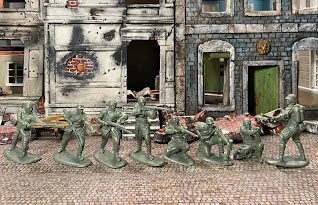The Greek Army during WWII was a relatively modest formation. At the start of the war, after mobilizing its reserves, it was able to field a force of 430,000 men. They were organized into 6 infantry divisions, 9 mountain divisions, 1 cavalry division, and 4 mountain brigades. By March of 1941, its army had grown to 540,000. Unfortunately, it did not have any mechanized units, other than a pseudo division of 2000 conscripted garage mechanics serving a 'force' of 24 light tanks/tankettes. Their Air Force was not much stronger, with only 44 fighters in its ranks. I suppose the Greek General Staff calculated that the mountainous terrain guarding the Greek borders made mechanized warfare impractical, and decided to focus its doctrine on mountain warfare. As we are about to see, this turned out to be correct against the Italians, but failed terribly against the Germans.
The participation of the Greek Infantry during WWII can be divided into three phases. The first phase, starting on Oct 28, 1940, when they were fighting off the Italian invasion, which they did quite successfully. During this phase, the Greek Army switched from a defensive stance into the offensive. After just one week, they had already pushed the Italians back into Albania and for the next few months Italy was on the ropes until Germany came to its rescue. The second phase, started on April 6, 1941, when the Greek Army faced off against the German Army. This was entirely a defensive operation, fighting desperately on their own soil for their homeland. Unfortunately for them, the Greek and British Armies were no match for the German Blitzkrieg, which at the time was in high gear, wanting to get the campaign over as quickly as possible to avoid impacting the planned invasion of the Soviet Union that summer. The Greek Army surrendered just two weeks after the invasion began. Part of the Greek government and its Army escaped with the British into the Middle East, from which they were able to regroup and continue the fight. The third phase of the war was their contribution to the rest of the Allied war effort, fighting along them in North Africa and the Italian campaign. The invasion of Crete happened between May 20 and June 1st 1941, so even through the Greek Army was still defending its homeland at that point, Greece had already capitulated to Germany. So depending on how you want to account for this action, this could be part of the second or the third phase. All in all, even if the fighting spirit of the individual Greek soldier was high, the performance of the Greek Army as a whole was suboptimal. In terms of toy soldiers, we now have one set representing the Greek fighters. Let's take a look.

Plastic Platoon Greek Infantry
When I heard that Plastic Platoon was coming out with Greek troops, I was very excited about it, as I expected them to do as great a job as they had done with their prior sets. I have to admit however that I was a little disappointed. It was great that they chose to make Greek troops, which until now, had not been paid attention to in the hobby. But it would have been good if they had made at least eight poses or so. Instead, PP chose to release three other figures representing Greek Partisans to round up the set. That essentially gave us too little of both. As far as the three Greek infantry figures go, they are well made and I do like that one of them conveys the emotion that must have overcome them as an army of Paratroopers suddenly dropped on them.




